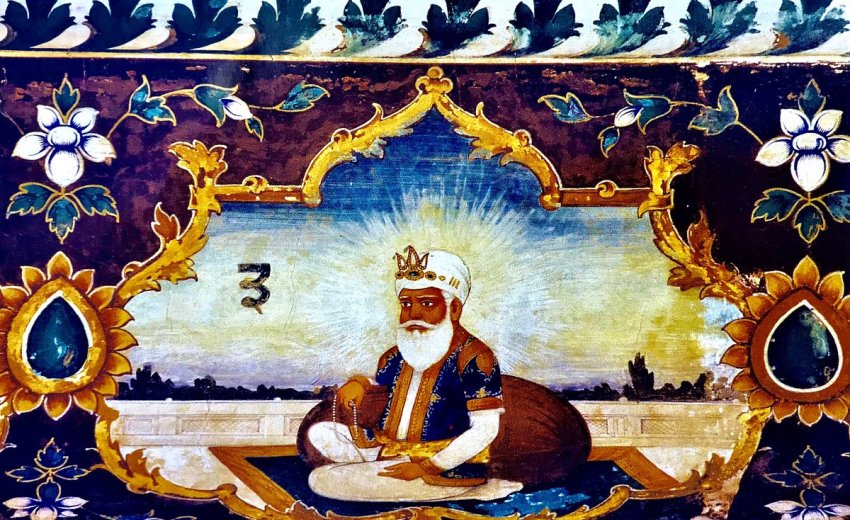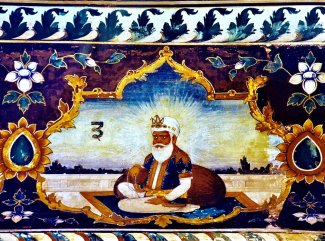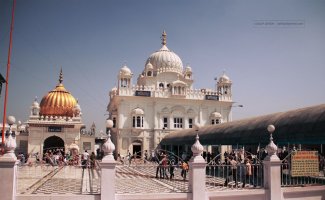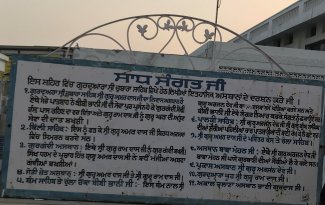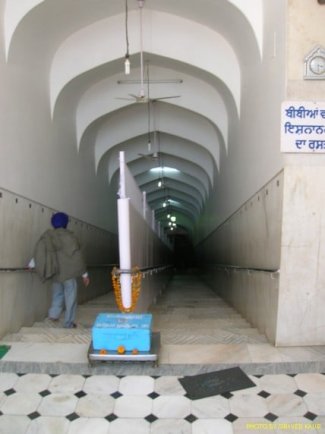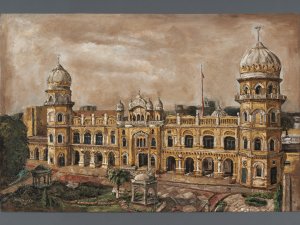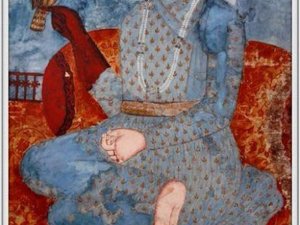Abstract
Guru Amar Das’s spiritual journey started late in his life with a quest for Guru, the spiritual Master, and it culminated in his becoming a Guru himself. A journey that started with a quest for Guru found him with Waheguru’s grace, then with Guru’s grace he experienced Waheguru -Truth (ਸਚੁ). The beauty of his life’s journey was his Guru saw his spiritual development then made him his own successor Guru. It was truly a spectacular journey of dedication, obedience, service, humility, firm faith, patience, constant awareness, and surrender. As we celebrate the 450th anniversary of his merger back into the Supreme Being, let us look into his life, achievements, and contributions.
Brief life- Guru Amar Das Ji (1) was born on 5th May 1479. As per his biological age he was only ten years younger than first Guru Nanak Dev Ji. He succeeded second Guru Angad Ji at Khadur Sahib becoming the third Guru at the age of 73, on March 29, 1552. He was the oldest of the ten Gurus to take the mantle at such an advanced age and was the oldest to shoulder the responsibly till 95. He merged into the Supreme Being on 1st September 1574.
During his adult life, he was engaged in the trade business and because of his staunch religious upbringing, he was a regular visitor to the Sacred Ganga (Ganges) river at Haridwar. He would go there bare footed, singing hymns, and giving alms to the poor, as a part of his pilgrimage activities (2). While returning from his twenty-first visit, he spent a night at the village of Maeharae accompanied by a Vaishav monk, who had become very close to him. This monk was so impressed by saintly qualities in Baba Amar Das, that he presumed in his head that Baba Ji was a Saint. When the monk was parting from Baba Ji, he asked who his Guru was? Baba Amar Das replied that he had no Guru (1). Shocked beyond a word, he regretted his time spent with him, adding that he had committed a sin by eating food prepared by Baba Ji. The response shook Baba Ji, left a deep imprint on his mind, giving birth to the quest of Guru.
One early morning Baba Amar Das Ji heard some hymns of Sri Guru Nanak Dev Ji from Bibi Amro Ji, wife of his nephew and daughter of Guru Angad Dev Ji. Baba Ji was so drawn by them that he requested her to take him to meet Guru Ji who authored those. Bibi Amro shared with Baba Ji that the composition was by Guru Nanak, who had anointed her father at Khadur as his successor. Then he requested her to take him there. Upon meeting Guru Ji, he was so impressed by the teachings, that he asked Guru Angad to make him his disciple. In terms of relationship Baba Ji was like Father-in-law of Guru Ji’s daughter and age wise 25 years older to him, so he was held in high veneration, but he was begging for discipleship.
It was his golden years, when people thought in terms of retiring and taking life easy after having worked hard through their lives, but Baba Amar Das chose a different path of Sewa. Upon being accepted, Baba Ji started living at Khadur Sahib to serve Guru Angad. First, he was engaged in quiet meditation and would only come for meals in the Langar Hall. Soon he realized that the austerities practiced in Guru’s house was in essence selfless service. So, he started serving water to the thirsty. Later, he expanded his role by cleaning soiled dishes, carrying bricks for construction, mixing mortar, hand grinding of grains, manual fanning, fetching wood fuel, giving massages and helping people with bath. One day a thought occurred to him that Guru Angad takes bath in the early morning, why not get fresh water from the river Beas for it. Soon, with permission from the Guru Ji it became his daily early morning routine. Every morning, he used to carry water in a metal pitcher from the river Beas about 5 KM away for Guru Angad’s bath. He couldn’t bear giving his back to the Guru, so he would walk backwards on his way to the river. Next, he would go to the forest to gather fuel wood for cooking. During the rest of the day, he would help other devotees and serve in the langar (3). Even after the evening meal he would come to serve Guru Angad. Despite his advanced age and a strenuous daily regimen, he was always fully enthusiastic and ready to serve everyone. The words, “I am tired and need some rest” never entered his vocabulary. His own personal comfort was willingly sacrificed for the sake of Guru, as he considered that a reverential act.
Shortly after he had moved to Khadur, his family folks visited him and pleaded with him to return back (1). His younger brother shared that the business was suffering in his absence, and how the family was struggling in hard times and needing his stewardship most now. But after listening Baba Ji replied that he does not have any family anymore. In desperation they approached Guru Angad Ji and asked him to make Baba Ji change his mind. But Baba Ji came there, told Guru Angad that they don’t know his state of mind, so don’t pay any attention to their pleadings. Baba Ji stayed back in Khadur carrying on his Sewa without any slack.
Because of his life’s approach, others considered as an old man without for zest of life. They called him “Amru – Nithavan” by using a derogatory moniker. “Nithavan” means without an abode or homeless, a moniker that he earned for his dedicated service at his daughter-in-law’s parents place, which was considered as below dignity by the prevalent social norms. The twelve years of dedicated service from 1541 was also a period of progressive spiritual growth in him. He later stressed about the importance of serving Guru describing its benefits in these words (3):
ਗੁਰ ਕੀ ਕਾਰ ਕਮਾਵਣੀ ਭਾਈ ਆਪੁ ਛੋਡਿ ਚਿਤੁ ਲਾਇ ॥
ਸਦਾ ਸਹਜੁ ਫਿਰਿ ਦੁਖੁ ਨ ਲਗਈ ਭਾਈ ਹਰਿ ਆਪਿ ਵਸੈ ਮਨਿ ਆਇ ॥੨॥
“Gur kee kaar kamaavanee bhaiee aap chhodd chit lai. ||
Sadhaa sahaj fir dhukh na lagiee bhaiee har aap vasai man aai. 2.” (SGGS, Pg. No. 639)
Translation: Work sincerely to serve the Guru, O Siblings of Destiny; abandon self-conceit, and with full concentration of mind.
You shall be in poise and peace forever, and you shall not be afflicted by any sorrow, O Siblings of Destiny; the God Himself shall come and abide in your mind. ||2||
One day, Guru Angad instructed Baba Amar Das to go to Goindwal, to spearhead setting up a new township there. Bowing to his Guru’s he took orders accepting the Sewa. The township was inaugurated by Baba Amar Das, which later evolved into first pilgrimage place of the Sikhs. Bhai Gurdas has described in his Vaar 1.46 that setting up of Goindwal was a tremendous feat.
Contributions and Achievements -One morning Baba Ji was returning back from Beas River with water for Guru Ji’s bath. Because of the whole night’s heavy downpour, and poor visibility he stumbled down accidentally on the wooden peg of the weaver’s loom. He fell and rolled down into the weaver’s pit. The weaver heard the sound from his bed, and he shouted out who was there. His wife responded who else it could be, besides homeless Amru. Baba Ji overheard her words and remarked that she was crazy as he was not homeless, rather had found the right Guru’s house. Soon the news reached Guru Ji and he called and embraced Baba Ji, declared him as the successor, by anointing him as the third Guru Nanak on March 1552 at the age of 73. At the time of anointing Guru Angad blessed the designate Guru with twelve blessings which included being: Honor of the humble (ਨਿਮਾਣਿਆਂ ਦੇ ਮਾਣ / Nimanian dae maan) and Power of the weakling (ਨਿਤਾਣਿਆਂ ਦੇ ਤਾਣ /Nitanian dae taan) etc. These were the blessings of his Guru, who had been enraptured by his dedicated services, obedience, humility and devotion. While he found his own two sons lacking in these qualities that responsibility entailed. He told them that Baba Amar Das came to Khadur to give up his own ego and selfhood. Bhai Gurdas (5) has painted a realistic picture of aura of Guru Amar Das Ji, who had received blessing from Guru Angad in these words:
ਲਹਣੇ ਪਾਈ ਨਾਨਕੋ ਦੇਣੀ ਅਮਰਦਾਸਿ ਘਰਿ ਆਈ।
ਗੁਰੁ ਬੈਠਾ ਅਮਰੁ ਸਰੂਪ ਹੋਇ ਗੁਰਮੁਖਿ ਪਾਈ ਦਾਤਿ ਇਲਾਹੀ।
“Lahane paiee naanako dhenee amaradhaas ghar aaiee.
Gur baiThaa amar saroop hoi gurmukh paiee dhaat ilaahee.” (Bhai Gurdas, Vaar 1.46)
Translation: Whatever Lahina (Guru Angad) got from Guru Nanak was passed on to the house of (Guru) Amar Das.
Having received the celestial gifts from Guru Angad, the Guru, in the form of Amar Das assumed the seat.
Guru Amar Das’s achievements were extremely admirable because he was blessed with celestial gifts. His dedication and his enthusiasm were legendary, while his physical stamina was untiring, his mental strength was like a high peak. After anointing Guru Amar Das as his successor, Guru Angad instructed him to establish his headquarters in the newly built township of Goindwal. Thus, Guru Amar Das spent a total of 33 years of his life in Goindwal.
Upon assuming the responsibilities of Guru, he furthered the development of the Sikhi movement, by providing the nascent community with a structured organization, and developing the first religious axis of Goindwal (3). He further strengthened the tradition of free kitchen (Guru Ka Langar) established by the earlier two Gurus. He issued an injunction saying ‘Pehle Pangat Phir Sangat’ implying that anyone wishing to have an audience with him must partake in the langar first. Guru Ji’s intended purpose was that such a practice was to remove caste restrictions along with the associated segregation practices. Many people were engaged in preparation, serving and cleaning in the langar, thus it became an incubator further helping in the idea of serving as well demolishing the social caste walls, with everyone jointly involved in all the activities without any caste discrimination. When emperor Akbar came to see Guru Ji in 1566, he had to eat the coarse rice in the Langar, before he could have an audience with Guru Ji. Akbar was impressed by this practice expressed his desire to grant some royal property for ‘Guru ka Langar’. But Guru Ji politely declined the offer saying that this institution is run by contributions of common man, and not dependent on state largesse.
He propagated the Sikh faith in a very planned manner by dividing the Sikh Sangat areas into 22 preaching centers (Manjis), each under the charge of a devout Sikh3. Further in 1558, he personally undertook tour of famous pilgrim centers in the east and also sent out Sikh missionaries to different parts of India to propagate Sikhism.
Upon returning back to Goindwal from the preaching tour he noticed that the number of visitors there had grown tremendously. So, he purchased some land therr and laid the foundation of a Bawli – a stepped well in 1559 to mitigate water shortage.
Sikhs in large number joined in the digging of the well. There were eighty-four steps leading down to the water level. Thus, Goindwal became the first pilgrimage center with a designated annual fair on the occasion of Vaisakhi.
For our understanding and inspiration, let us look into what Guru Ji has said and written about the significance of altruistic service.
ਹਰਿ ਕੀ ਤੁਮ ਸੇਵਾ ਕਰਹੁ ਦੂਜੀ ਸੇਵਾ ਕਰਹੁ ਨ ਕੋਇ ਜੀ ॥ ਹਰਿ ਕੀ ਸੇਵਾ ਤੇ ਮਨਹੁ ਚਿੰਦਿਆ ਫਲੁ ਪਾਈਐ ਦੂਜੀ ਸੇਵਾ ਜਨਮੁ ਬਿਰਥਾ ਜਾਇ ਜੀ ॥੧॥
“Har kee tum sevaa karahu dhoojee sevaa karahu na koi jee. Har kee sevaa te manahu chi(n)dhiaa fal paieeaai dhoojee sevaa janam birathaa jai jee. 1.” (SGGS, Pg. No. 490)
Translation: Serve (and worship) the Lord alone; do not serve anyone else (lesser gods, goddess, or human beings). Serving the Lord, you shall obtain the fruits of your heart's desires; (while) serving other your life shall pass away in vain. ||1||
Guru Ji has even shared how service has to be carried out:
ਗੁਰ ਕੀ ਕਾਰ ਕਮਾਵਣੀ ਭਾਈ ਆਪੁ ਛੋਡਿ ਚਿਤੁ ਲਾਇ ॥
ਸਦਾ ਸਹਜੁ ਫਿਰਿ ਦੁਖੁ ਨ ਲਗਈ ਭਾਈ ਹਰਿ ਆਪਿ ਵਸੈ ਮਨਿ ਆਇ ॥੨॥
“Gur kee kaar kamaavanee bhaiee aap chhodd chit lai.
Sadhaa sahaj fir dhukh na lagiee bhaiee har aap vasai man aai. 2.” (SGGS, Pg. No. 639)
Translation: Work to serve the Guru, O Siblings of Destiny; abandon self-conceit, and focus your consciousness.
You shall be in peace forever, and you shall not suffer in pain any longer, O Siblings of Destiny; the Lord Himself shall come and abide in your mind. ||2||
Guru Amar Das has shared essentiality of spiritual development by saying:
ਏਸ ਨਉ ਹੋਰੁ ਥਾਉ ਨਾਹੀ ਸਬਦਿ ਲਾਗਿ ਸਵਾਰੀਆ ॥
“Es nau hor thaau naahee sabadh laag savaareeaa.” (SGGS, Pg. No. 917)
Translation: For the self, there is no other shelter worth seeking, it can be made noble by devotion to the Holy Word.
Guru Ji asked to serve none other than the Creator (for him Guru and Creator were one), simultaneously he pointed out the futility of serving others, totally based on his own personal experiences. The outcome of such a service has been defined by Guru Ji as that the heart’s true inner quest will be fulfilled:
ਜਿਚਰੁ ਅੰਦਰਿ ਸਾਸੁ ਤਿਚਰੁ ਸੇਵਾ ਕੀਚੈ ਜਾਇ ਮਿਲੀਐ ਰਾਮ ਮੁਰਾਰੀ ॥੨੫॥
“Jichar a(n)dhar saas tichar sevaa keechai jai mileeaai raam Muraaree. 25.”
(SGGS, Pg. No. 911)
Translation: As long as there is breath within you, so long you should serve the Lord; then, you will go and meet the Lord. ||25||
Guru Ji continued to actively promote the call to service till the very end at the ripe age of 95, along with providing leadership and direction to the community. His own words define that biological age does not leave its physically debilitating impairment imprint on the Guru oriented. As they get that mental strength which invigorates their physical body in these words3:
ਗੁਰਮੁਖਿ ਬੁਢੇ ਕਦੇ ਨਾਹੀ ਜਿਨ੍ਹ੍ਹਾ ਅੰਤਰਿ ਸੁਰਤਿ ਗਿਆਨੁ ॥
“Gurmukh budde kadhe naahee jin(h)aa a(n)tar surat giaan.” (SGGS, Pg. No. 1418)
Translation: The Gurmukhs never grow old; within them is intuitive understanding and spiritual wisdom of One Divine Power.
Conclusion
The occasion of the 450th anniversary of Guru Amar Das’s merger into the Supreme Being is an inspiration to all of us, that age is not a bar for embarking on spiritual journey. Dedication and commitment can bring about inner transformation even at a later age. Let his life be our inspiration, and we try to inculcate Guru Ji’s advice in Sri Guru Granth Sahib Ji to mold our life. Guru Ji has defined the prerequisite of becoming a true Sewak is to become free of ego in these words:
ਨਾਨਕ ਸੇਵਕੁ ਸੋਈ ਆਖੀਐ ਜੋ ਸਿਰੁ ਧਰੇ ਉਤਾਰਿ ॥
“Nanak sevak soiee aakheeaai jo sir dhare utaar.” (SGGS, Pg. No. 1247)
Translation: O Nanak, he alone is called a selfless servant, who does a complete surrender to the Lord.
Let us try to emulate the example set by Guru Amar Das Ji.
References:
- Singh, Satbir. Parbat Meran. New Book Co., Jalandhar. PP 11, 32, 33
- Singh, Puran. The Ten Masters, Singh Brothers, Amritsar. PP 57, 61
- Author unlisted. Sikh Religion. Sikh Missionary Center, Detroit, Michigan. PP 81-93
- Author unlisted. Sankhep Jeewan Sri Guru Amardas Ji. Gurdwara Sri Baoli Sahib, Goindwal. PP 5, 19, 34.
- Jawa, Ujagar Singh. Bhai Gurdas Ji, Biography and Compositions, Volume 1. The Washington Sikh Center, Gaithersburg, MD. PP 94

